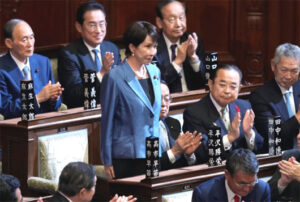Analysis by WorldTribune Staff, October 26, 2025 Real World News
Ahead of her first meeting with President Donald Trump on his Asian tour, newly elected Japanese Prime Minister Sanae Takaichi was being viewed as a nightmare come true for globalists and their “legacy media.” But she, like the late Shinzo Abe, is the primary threat for the Chinese Communist Party (CCP) which needs a pacified Japan to advance regional and global ambitions.

The misrepresentation of Takaichi in domestic and foreign legacy media reveals a pattern “that not only distorts public understanding, but inadvertently amplifies foreign disinformation campaigns targeting the nation’s democracy,” Stephen R. Nagy noted in an Oct. 24 analysis for the Japan Times.
Most descriptions of the new prime minister in left-wing media outlets paint her as “far-right,” “revisionist,” or “ultraconservative.”
Related: Emerging from Abe’s shadow, Japan’s ‘Iron Lady’ opposes China and same sex marriage, October 5, 2025
“We have seen this show before,” noted Nagy, a professor of politics and international studies at the International Christian University in Tokyo and a visiting fellow with the Japan Institute for International Affairs.
“Trump as Hitler; and Abe as an archconservative committed to remilitarizing Japan. These inflammatory depictions disseminated by mass media and social media are widespread and damaging.”
Across CNN, Al Jazeera, CNBC Asia and other major outlets, interviews Nagy said he has given on Takaichi “invariably begin with descriptors like ‘ultraconservative nationalist,’ ‘China-hawk,’ or ‘far-right politician.’ These are loaded terms that predetermine audience perception before any substantive discussion begins.”
Subscribe to Geostrategy-Direct
“While Takaichi opposes quotas and supports traditional family structures, she herself shattered Japan’s ultimate glass ceiling as the nation’s first female prime minister,” he noted. “Her career trajectory — rising through the male-dominated LDP hierarchy through political skill and persistence — embodies female empowerment through merit rather than mandates.”
Generalizations and misrepresentation on all issues “becomes especially dangerous when it intersects with documented foreign disinformation campaigns.”
For example, he wrote:
Research by the University of Calgary’s Jean-Christophe Boucher and Kyoko Kuwahara from the Japan Institute for International Affairs has identified coordinated Chinese and Russian information operations targeting Japanese elections and political figures. These campaigns exploit existing media narratives, amplifying divisive characterizations to undermine public trust and exacerbate social tensions. … To illustrate: Takaichi as militarist, Japan as remilitarizing, the LDP as extreme. This aligns with their strategic objectives of weakening the U.S.-Japan alliance and isolating Japan diplomatically.
Nagy pointed to three urgent recommendations he would like to see emerge from this disastrous status quo:
First, media organizations must implement “context checks” alongside fact checks. Before labeling any politician with inflammatory terms, editors should require reporters to provide comparative context. Is Takaichi more conservative than the median LDP member? How do her positions compare to public-opinion polling? What specific policies justify particular characterizations? This systematic contextualization would expose the hollowness of much current coverage.
Second, news organizations should establish “disinformation impact assessments” for political coverage. Before publication, editors should ask: How might foreign state actors exploit this framing? Does our characterization align with known disinformation narratives? Are we inadvertently amplifying strategic messaging designed to undermine democratic allies? The Canadian information warfare lab model that Boucher describes could provide frameworks for such assessments.
Third, academic institutions must recommit to analytical rigor in political commentary. Universities should distinguish between scholarly analysis and political advocacy, ensuring that expert commentary maintains professional standards of evidence and argumentation. When professors invoke Hitler comparisons or use apocalyptic language about democratic politicians, they debase academic discourse and enable media sensationalism.
“Japan’s democracy faces genuine challenges such as demographic decline, economic stagnation and regional security threats. Addressing these requires clear-eyed analysis and informed public debate. When media coverage reduces complex political figures to caricatures and amplifies foreign disinformation campaigns, it undermines the very democratic discourse necessary for effective governance,” Nagy wrote.
Meet Japan’s first female Prime Minister, Sanae Takaichi 🇯🇵
Japan is a traditional, patriarchal society so you’d imagine Feminists would be cheering from the rooftops over Takaichi’s historic achievement. But nope. Not a peep. Total silence.
Here’s why:
– Takaichi is a… pic.twitter.com/DkQDISAGZF
— Benny Johnson (@bennyjohnson) October 22, 2025
